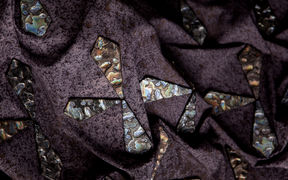Hollywood costume design goes sustainable

‘I’ve worked for many years as a textile artist and costume maker in theatre, television and film, which often means using toxic and unsustainable substances. These, of course, aren’t very good for the people working with them ― or for the environment. When I came to Aalto University, I got interested in finding alternatives,’ says Urs Dierker, who relocated to the Helsinki area last year.
Glues and solvent-based spray paints as well as plastic-based materials are part of day-to-day life on many film sets. With the industry taking symbolic steps to go green ― from the Oscars taking on vegan-based menus and the BAFTAs going carbon-neutral ― Dierker is one of the many industry professionals looking to integrate more sustainable practices into TV and film production.
His approach, however, is unique.
Raw materials from a walk in the woods
Together with Aalto University experts in chemical engineering, Dierker has looked to wood, fungi and bacteria to find chemical-free, non-toxic ways of treating materials used in costumes.
Cellulose, one of the most abundant biomaterials on Earth and easily derived from wood, shows exceptional promise.
‘Working with Professor Orlando Rojas’ research group including Noora Yau’s and Konrad Klockars’ Structural Colour Studio, I’ve used a cellulose-based, pigment-free paint. The wood reflects light to create colour without any kind of dye or chemical treatment,’ explains Dierker. ‘We’re able to create shiny, iridescent effects made purely from wood.’

Hand-in-hand with Aalto researchers, the textile artist has also found possibilities for costume design in some less-than-obvious friends from nature.
‘I’ve been experimenting with using bacteria and mycelia ― a sort of mushroom-in-growth ― to colour materials without harsh dyes. We’ve made some gorgeous, fade-resistant indigo-based blue, in just a couple days!’

Movie sets double as a laboratory
On top of pushing for change in on-set practices, Dierker sees costume design as the ideal platform to test out fresh materials and designs.
‘If you think about how costumes are made, a film or TV production is a great environment to test new sustainable materials out ― to show that they are workable. You select the materials, make the costume, and soon you have answers about what works. During the performance on-set and care for the garments afterwards you know what holds up over time. Costumes can essentially give us immediate answers about how people use clothes,’ he says.
Dierker’s next step is to find a production, either in television, film or theatre, to bring these new techniques into a larger scale. His vision doesn’t stop there, though.
‘To make costume design greener, we still need to come together and address a lot of other angles to see how sustainable substances can find their way from petri dish to performance.’
- Urs Dierker has worked on hit TV shows shot in Toronto like The Handmaid’s Tale and Star Trek: Discovery
- His exhibition, Naturally Dramatic, on sustainable costume design was featured as part of Designs for a Cooler Planetat Helsinki Design Week 2020
Naturally Dramatic
A science-art project aimed at textiles and materials that contribute to more sustainable practices in costume making by using cellulose-based materials.

Read more news

Research Council of Finland establishes a Center of Excellence in Quantum Materials
The Centre, called QMAT, creates new materials to power the quantum technology of coming decades.
Two Unite! Seed Fund projects involving Aalto secure top EU funding
Two prestigious EU grants have been awarded to projects that were initially supported with Unite! Seed Funding. Both projects involve Aalto.
Major funding powers development of next-generation machine technology aimed at productivity leap in export sectors
The BEST research project is developing new types of sealing, bearing, and damping technology.






